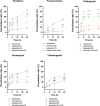Mutations of the complex I PSST target gene confers acaricide resistance and a fitness cost in Panonychus citri
- PMID: 40597320
- PMCID: PMC12220261
- DOI: 10.1186/s12915-025-02288-7
Mutations of the complex I PSST target gene confers acaricide resistance and a fitness cost in Panonychus citri
Abstract
Background: Pesticide resistance is a serious problem that threatens crop industries. Major resistance towards pyridaben, an acaricidal inhibitor of mitochondrial electron transport complex I (METI-Is), has been reported in tetranychids following its extensive use worldwide. Understanding mechanisms of pyridaben resistance is crucial for sustainable resistance management.
Results: The inheritance of pyridaben resistance was incompletely recessive and controlled by multiple genes in P. citri, which was determined by reciprocal crosses and backcross experiments. Bulked segregant analysis was performed to identify gene loci underlying pyridaben resistance. Subsequently, the two PSST-subunit mutations H107R and the previously undiscovered V103I mutation were positively correlated with pyridaben resistance in different populations or strains by single mite genotyping. The bioassay further showed that H107R contributed to moderate resistance, while V103I in combination with H107R was responsible for a very high level of resistance in homozygous P. citri strains. These contributions to pyridaben resistance were also verified in transgenic Drosophila through the introduction of the wildtype, single- or double-mutated P. citri PSST subunit. In addition, life-table analysis and behavioral measures were conducted to assess the fitness cost associated with resistance development. Accompanied by reduced ATP levels and complex I activity, a fitness cost was observed as reduced fecundity and lower mobility due to PSST mutations.
Conclusions: Our findings provide direct evidence that PSST mutations conferred the evolution of pyridaben resistance but simultaneously led to a fitness cost due to functional defects in complex I. These data provide theoretical insights into sustainable resistance management in agricultural production.
Keywords: Bulked segregation analysis; Citrus red mite; Fitness cost; Inheritance; Target-site mutation.
© 2025. The Author(s).
Conflict of interest statement
Declarations. Ethics approval and consent to participate: Not applicable. Consent for publication: Not applicable. Competing interests: The authors declare no competing interests.
Figures









Similar articles
-
Recurrent mutations drive the rapid evolution of pesticide resistance in the two-spotted spider mite Tetranychus urticae.Elife. 2025 Aug 11;14:RP106288. doi: 10.7554/eLife.106288. Elife. 2025. PMID: 40788297 Free PMC article.
-
The dual role of the RR-2 cuticular protein gene in development and acaricide susceptibility of Panonychus citri (Acari: Tetranychidae).Exp Appl Acarol. 2025 May 27;95(1):5. doi: 10.1007/s10493-025-01029-3. Exp Appl Acarol. 2025. PMID: 40423860
-
The effectiveness and cost-effectiveness of carmustine implants and temozolomide for the treatment of newly diagnosed high-grade glioma: a systematic review and economic evaluation.Health Technol Assess. 2007 Nov;11(45):iii-iv, ix-221. doi: 10.3310/hta11450. Health Technol Assess. 2007. PMID: 17999840
-
Electronic cigarettes for smoking cessation.Cochrane Database Syst Rev. 2022 Nov 17;11(11):CD010216. doi: 10.1002/14651858.CD010216.pub7. Cochrane Database Syst Rev. 2022. Update in: Cochrane Database Syst Rev. 2024 Jan 8;1:CD010216. doi: 10.1002/14651858.CD010216.pub8. PMID: 36384212 Free PMC article. Updated.
-
Electronic cigarettes for smoking cessation.Cochrane Database Syst Rev. 2021 Sep 14;9(9):CD010216. doi: 10.1002/14651858.CD010216.pub6. Cochrane Database Syst Rev. 2021. Update in: Cochrane Database Syst Rev. 2022 Nov 17;11:CD010216. doi: 10.1002/14651858.CD010216.pub7. PMID: 34519354 Free PMC article. Updated.
References
MeSH terms
Substances
Grants and funding
- SWU-XDPY22001/Fundamental Research Funds for the Central Universities
- SWU-XDPY22001/Fundamental Research Funds for the Central Universities
- SWU-XDPY22001/Fundamental Research Funds for the Central Universities
- SWU-XDPY22001/Fundamental Research Funds for the Central Universities
- SWU-XDPY22001/Fundamental Research Funds for the Central Universities
LinkOut - more resources
Full Text Sources

